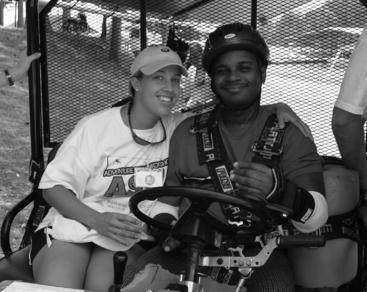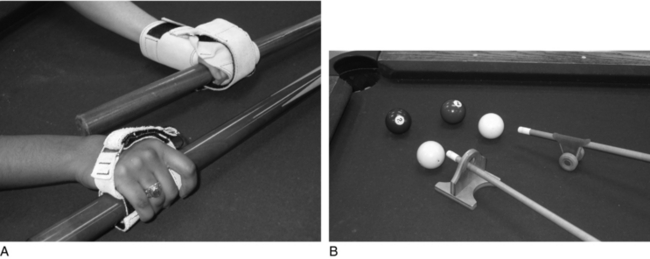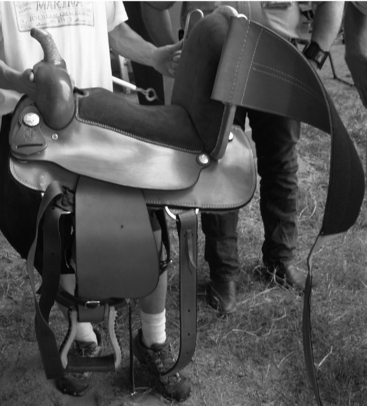Chapter 48 Sports adaptations for the physically challenged athlete
All-terrain vehicles
The two main categories of ATVs that people with physical disabilities use are four-wheelers and utility vehicles. A four-wheeler should be driven only by someone who has the upper extremity functioning and trunk balance necessary to safely operate the vehicle. Under no circumstance should drivers ever strap themselves onto a four-wheeler. Individuals with decreased lower extremity functioning and sensation may need to select a four-wheeler that is automatic, and they may need to pad off the engine or the sides of the vehicle to protect their skin from the vehicle’s heat.
For utility vehicle users, seat belts are a standard feature and should be used by anyone with decreased balance and stability. A harness system similar to that used in racing cars can be added as extra support for individuals with little to no trunk balance. Foam padding can be placed between the individual, the vehicle, and the harness system to provide even greater stability. The foot accelerator and braking systems can be converted to a hand control system for individuals with decreased lower extremity functioning. For an individual with decreased grip, a grasping cuff can be used with the hand control system, and the steering wheel can be modified by adding a ball grip or a tripod wrist grip (Fig. 48-1).
Billiards
Several pieces of adaptive billiards equipment are available for individuals with decreased upper extremity functioning. Pool cuffs and grasping cuffs, which are secured to both the hand and the pool cue, can assist with gripping the pool cue (Fig. 48-2A). Prostheses can be used to hold a pool cue. Pool bridges can be used to help support and stabilize the tip of the pool cue. Generally, three types of bridges can be used: a standard pool bridge, a stationary bridge rest that sits on the pool table, and a mobile bridge that attaches to the tip of the pool cue (Fig. 48-2B).
Bowling
Bowling can be adapted to meet the physical abilities of any bowler. A bowler who lacks the finger strength and/or dexterity to completely grip a standard bowling ball can use a bowling ball with a spring-loaded handle or a bowling ball pusher. A bowler who is unable to bowl free-arm or use a ball pusher can use a bowling ramp. A standard bowling ramp can be placed in front of the lane, and the bowler releases the ball from the top of the ramp with a very light push (Fig. 48-3A). The spring-loaded handle bowling ball, the bowling ball pusher, and the standard bowling ramp all can be used from a seated or a standing position. A bowler who uses a wheelchair for mobility and has little to no upper extremity functioning can use a bowling ramp that attaches to his or her power wheelchair. The bowler controls the speed, direction, position, and timing of the release of the ball down the ramp by driving and stopping the wheelchair (Fig. 48-3B).
Cycling
Handcycles are arm-operated bicycles with a wide, backed seat that accommodates and provides support for the cyclist’s frame. Lateral supports can be added to the backrest to provide greater stability for a cyclist with decreased trunk control. Handcycles are equipped with multiple gears and hand brakes, and they are propelled by a crank system that is connected to the front fork. Tripod wrist cuffs, universal cuff style handles, grasping cuffs with hooks, and prostheses can be used to assist cyclists with grasping the crank handles. All of these grasping devices allow for cyclists to move between the handles, gears, and brakes as needed.
Equestrian sports
Horseback riding can be enjoyed as a therapeutic modality, a leisure activity, and a competitive sport by individuals with physical disabilities. Riders who cannot mount a horse by climbing up on it often use a ramped platform that positions them at the height of the horse’s back. Many riders customize their saddles to meet their needs. Extra padding can be added to the saddle to guard against skin sores from pressure and shearing. Riders who need assistance with balance can attach a backrest to the saddle, and a bellyband can be used to secure their trunk to the backrest (Fig. 48-4). Stirrups can be customized and are important for maintaining balance and protecting a rider’s legs from injury. For riders with decreased trunk control who cannot sit on a horse, carriage driving is another option. In carriage driving, a horse pulls a carriage that is designed to accommodate a wheelchair or an adaptive seat. Access to the carriage typically is gained through a ramp or a hydraulic lift on the back of the carriage, and the carriage has a built-in safety system that secures the wheelchair to the carriage. The reins and how the reins are held can be adapted to allow drivers with decreased grip to control the horse.
Extreme sports
Paragliding, hang gliding, and skydiving can be done in tandem by someone with decreased lower extremity functioning, trunk control, and/or upper extremity functioning. Gliders and divers with visual impairments can communicate with a buddy through the use of headphones. Hand controls can be adapted and landing techniques modified to meet the needs of the individual taking to the air. Protective padding can be used to prevent injuries upon landing.












